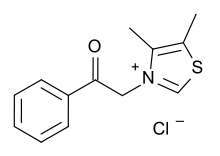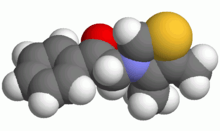Alagebrium
 | |
 | |
| Systematic (IUPAC) name | |
|---|---|
| 4,5-dimethyl-3-(2-oxo-2-phenylethyl)-thiazolium chloride | |
| Clinical data | |
| Identifiers | |
|
341028-37-3 | |
| None | |
| PubChem | CID 216306 |
| ChemSpider |
187495 |
| UNII |
DGH49JXB1F |
| ChEMBL |
CHEMBL2107309 |
| Chemical data | |
| Formula | C13H14ClNOS |
| 267.774 g/mol | |
|
SMILES
| |
| |
| | |
Alagebrium (formerly known as ALT-711) was a drug candidate developed by Alteon Corporation. It was the first drug candidate to be clinically tested for the purpose of breaking the crosslinks caused by advanced glycation endproducts (AGEs), thereby reversing one of the main mechanisms of aging.[1] Through this effect Alagebrium is designed to reverse the stiffening of blood vessel walls that contributes to hypertension and cardiovascular disease, as well as many other forms of degradation associated with protein crosslinking.[2][3][4] Alagebrium has proven effective in reducing systolic blood pressure[5] and providing therapeutic benefit for patients with diastolic heart failure.[6]
Mechanism
AGEs are structures that form irreversibly when carbohydrates react non-enzymatically with proteins, lipids, or DNA. Many proteins, including structural proteins such as collagen and elastin, play an integral role in the architecture of tissues and organs and maintenance of cardiovascular elasticity and vascular wall integrity. Accumulation of these glycocedic cross-linkages can impair the normal function of organs, thicken arteries, stiffen muscles, or lead to other characteristic declines of biolological aging.[7] In addition to this, the formation of AGE crosslinks leads to increased stiffness and loss of function of tissues and organs, and abnormal protein accumulation, which together cause many of the complications of aging and diabetes. Diabetic individuals form excessive amounts of AGEs earlier in life than non-diabetic individuals. AGEs are also known to induce oxidative stress, in which reactive molecules provoke the underlying component of inflammation.
Pharmacologic intervention with alagebrium directly targets the biochemical pathway leading to the stiffness of the cardiovascular system. Removal of the AGEs by cleavage of the abnormal crosslinking bonds has been associated with diminished inflammatory and sclerotic signaling pathways. These pathways are responsible for the deposition of abnormal amounts of matrix proteins that physically stiffen tissues. The presence of AGE crosslinks also renders tissues and organs less susceptible to normal turnover thus enhancing the presence of these abnormal bonds on various molecules. Importantly, alagebrium does not disrupt the natural carbohydrate modification to proteins, intra-molecular crosslinking or peptide bonds that are responsible for maintaining the normal integrity of the collagen chain. Thus, normal structure and function is preserved while abnormal crosslinking is reduced.[7]
Although alagebrium may break some important AGE crosslinks, there is no evidence that it is effective against the most prevalent crosslink: glucosepane.[8]
History
The chemical compound had been discovered many years ago, and had traveled a circuitous route through academia, research firms, and finally, Alteon. There are two prominent attributes to Alagebrium (as Alteon renamed it). The first is that it is not a difficult compound to synthesize. An active market arose very quickly after the early Phase I and II tests ended. Independent, lab-tested, certified for purity product was available for a short time on the market at about $3 per gram.
Although Alagebrium has shown very promising Phase I and II clinical trials, active research stopped because Alteon had run out of operating cash.[9] Alteon, having a huge amount of convertible preferred stock hanging over its head (held by Genentech), had increasing difficulty raising subsequent levels of venture capital until finally, it was unavailable at any price. On 25 July 2007 Alteon was bought by a three-man operation developing another medication. The company changed its name to Synvista Therapeutics, Inc, and announced that it was terminating clinical trials in January 2009.[10] The company seems to have discontinued operations and their website is no longer available.
See also
- Glycation
- Glycosylation
- Glucosepane
- Advanced glycation end product
References
- ↑ "R&D overview: A.G.E. crosslink breakers and Alagebrium". Alteon Corporation. Archived from the original on 1 July 2007. Retrieved 2007-07-04.
- ↑ "Product Candidate: A.G.E. crosslink breakers". Alteon Corporation. Archived from the original on 1 July 2007. Retrieved 2007-07-04.
- ↑ Lisa Melton (June 2000). "AGEing – breaking the bonds" (2). Novartis Foundation Bulletin. Archived from the original on 6 August 2007. Retrieved 2007-07-04.
- ↑ Carmia Borek (Aug 2001). "Age breakers" (2). Life Extension Magazine. Retrieved 2007-07-04.
- ↑ Bakris GL, Bank AJ, Kass DA, Neutel JM, Preston RA, Oparil S (2004). "Advanced glycation end-product cross-link breakers. A novel approach to cardiovascular pathologies related to the aging process". American Journal of Hypertension 17 (12 Pt 2): 23S–30S. doi:10.1016/j.amjhyper.2004.08.022. PMID 15607432.
- ↑ Little WC, Zile MR, Kitzman DW, Hundley WG, O'Brien TX, Degroof RC (2005). "The effect of alagebrium chloride (ALT-711), a novel glucose cross-link breaker, in the treatment of elderly patients with diastolic heart failure". Journal of Cardiac Failure 11 (3): 191–195. doi:10.1016/j.cardfail.2004.09.010. PMID 15812746.
- ↑ 7.0 7.1 Melton, Lisa (July 2000). "AGE Breakers". Scientific American.
- ↑ Monnier VM, Sell DR (2006). "Prevention and repair of protein damage by the Maillard reaction in vivo". Rejuvenation Research 9 (2): 264–273. doi:10.1089/rej.2006.9.264. PMID 16706654.
- ↑ "Alteon, Alagebrium, ALT-711", Fight Aging, 20 April 2007
- ↑ , Synvista-therapeutics-announces-termination-clinical-trials-alagebrium